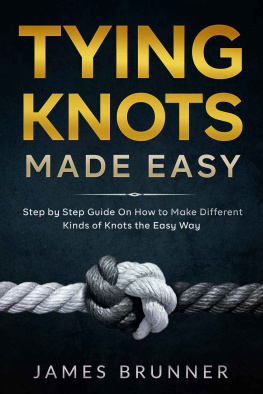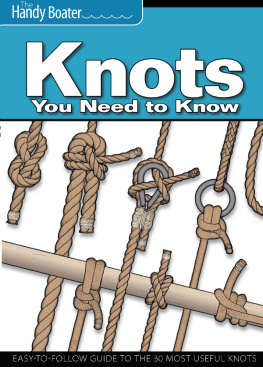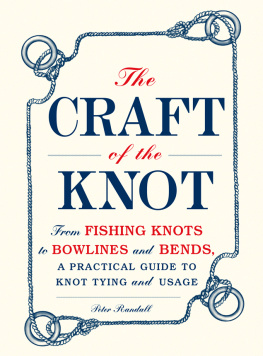STERLING and the distinctive Sterling logo are registered trademarks of Sterling Publishing Co., Inc.
2008, 2019 Sterling Publishing Co., Inc.
All rights reserved. No part of this publication may be reproduced, stored in a retrieval system, or transmitted in any form or by any means (including electronic, mechanical, photocopying, recording, or other wise) without prior written permission from the publisher.
For information about custom editions, special sales, and premium and corporate purchases, please contact Sterling Special Sales at 800-805-5489 or .
INTRODUCTION
Dressing well is a form of good manners.
Tom Ford
Knots mean business. They symbolize fertility, strength, unions, mystery, dilemmas, and solutions. A man in a tie means business, tooeven if that business has nothing to do with commerce and everything to do with looking his best. If youre going to wear a tie, you need to be able to knot it properly.
The Ashley Book of Knots, published in 1944, describes approximately 4,000 different knots. In 1999, Thomas Fink and Yong Mao, theoretical physicists at Cambridge, determined that you can use almost 100 of them specifically to tie a tie. Mikael Vejdemo-Johansson of the KTH Royal Institute of Technology in Stockholm wrote a scholarly paper in 2014 showing that 177,147 ways to tie a tie exist. If you want to look put together, you need to know how to tie only a smart selection of that number, which appear in this book.
Tying a knot doesnt take long to learn, and once youve mastered the basics its hard to forget how to do it correctly. Those basics come naturally enough, but they require practice for perfection. The more you do it, the better you get. Some men prefer using many different knots, while some stick with just one or two mainstays. Either way, its good to know a few moreor have them handily at your fingertips in the pages that followso you can vary your style to suit different collars, occasions, or moods. You might like how one complements the shape of your chin or makes a bold knot from a thin tie. Some ties are best when you want to shine or when you dont want to draw undue attention to yourself.
A well-chosen, smartly worn tie stands as one of the pillars of a mans style, so its important to get it right. After college, the average adult male dresses and undresses roughly 18,000 times. Depending on your profession, calling, or sartorial worldview, you may be choosing and knotting a veritable mountain of ties. But even if youre not a tie guy, consider the following: Job interviews, weddings, funerals, religious events, charity gatherings, and certain soirees all require the presence of a tie around your neck. The color of the tie itself can indicate the formality level of the event. Also consider: Both Cary Grant and James Bond looked superb in a bow tie.
 A young Cary Grant looking dapper in a white bow tie.
A young Cary Grant looking dapper in a white bow tie.
Only Truman Capote, Tom Wolfe, and a few others could manage the tie as everyday apparel. Colonel Sanders somehow paired a string tie with a lifetime of southern-fried similes and parlayed himself into a fast-food luminary. Many a clammy gent sporting a clip-on, poly-blend necktie and a short-sleeve button-down shirt has stolen the show at a neighborhood social. Bond wouldnt be caught dead wearing either of these. Neither should you.
Youre holding this handy little tome, so you know the importance of style and avoiding the sartorial misdemeanors described above. You already know what not to do. But in a postcasual Friday world, in which mens style often smacks of the agnostic, even some of the basic rules can prove elusive. What are the standard length and width for a tie? Can a prospective employer or mate, five feet away, tell the difference between a cheap tie and a good one? Whats the best way to coordinate a ties weave and width with suit fabrics and lapels? What knots go with which collars? Whats proper tie etiquette?
In the following pages, youll find answers to these questions along with all of the basic rules and regulations for the art of wearing tiesand how to break them if you choose. Youll also encounter fun facts, tidbits of encouragement and admonition, and lore and wisdom from style icons past and present. You wont find a lot of fashion fuss, just the must-know guidelines, along with a few finer points for looking good while wearing a tie. Because even if youre not gaming in Monte Carlo or skiing the Matterhorn, you want to look your best.
A BRIEF HISTORY OF TIES
Theres never a new fashion but its old.
Geoffrey Chaucer
Men have been donning neckwear for a very long time. The tie itselfknown properly as a straight tieis well-designed, orderly, and has clean lines. Its history, on the other hand, is loose and unkempt, with an indistinct point of origin and blurry development. If you never liked history class, skip ahead to the next section, How to Choose a Tie (). But if you want to delve deeper into how and why we came to the practice of wrapping long strips of fabric around our necks, read on, good sir.
TIES TO WAR
Like many fashion trendssuch as parkas, cargo pants, camouflage, and aviator sunglassesthe tie began as an article of military utility. In 1974, near Xian, the ancient capital of China, archaeologists unearthed the tomb of Qin Shih Huang (259210 BC), the first Chinese emperor. In it, they found a phalanx of some 7,500 terra-cotta soldiers, each with a knotted scarf or neckerchief around his neck. Before this discovery, historians had credited the Romans with inventing the tie, called a focale, citing the 2,500 or so soldiers wearing them on Trajans Column, a war monument erected by Emperor Trajan in Rome in AD 113. In both cases, purely practical purposes prompted the usage. The tie absorbed sweat and protected soldiers necks from the elements. Subsequent Chinese artifacts show no one wearing neckwear like this from the third century BC until the 1600s, when European style began influencing Chinese fashions. Roman soldiers continued to sport their focalia for a time, but, as the empire Christianized, ties disappeared from history for a millennium and a half.
The straight tie, as we know it, descends from the cravat, which came of age after the Thirty Years War (16181648). King Louis XIII of France hired a regiment of Croatian mercenaries to help his fight against the Holy Roman Empire. The Croatians wore knotted neckerchiefs, eventually called cravats (from the French word for Croatian), to keep their necks warm. The look of the cravat appealed to the French soldiers, who created their own versiona collar stiffly starched and pressedbut that proved cumbersome both to wear and to maintain. French military men carried the look back to the French court, where the fashion-conscious incorporated it into civilian style. Cravats then migrated from France to England with King Charles II, who returned from exile in King Louis XIVs court to England in 1660. At the same time, more sober cravats were sailing with the Puritans from England to the New World.











 Interior design by Christine Heun
Interior design by Christine Heun 
 A young Cary Grant looking dapper in a white bow tie.
A young Cary Grant looking dapper in a white bow tie.